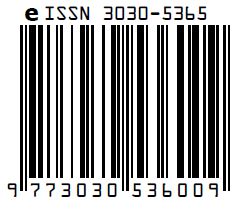Agricultural and Urban Land Use as Drivers of Aquatic Ecosystem Degradation: A Systematic Review
DOI:
https://doi.org/10.31674/ijbb.2025.v02i02.002Abstract
Abstract
Background:
Freshwater ecosystems are under increasing pressure from anthropogenic land use changes, particularly those related to agriculture and urban development. These land use types contribute to ecological degradation through the introduction of nutrients, sediments, and chemical pollutants, as well as the alteration of hydrological and habitat dynamics. Understanding the extent of nature and these impacts is significant for the conservation and management of watershed ecosystems.
Objectives:
This research aimed to systematically synthesize and review current supportable evidence on the effects of farming and urban land use on water and aquatic quality biodiversity within watershed environments. It sought to (1) identify consistent patterns of water quality and biodiversity change associated with land use types, (2) examine the sensitivity of various ecological indicators to land use stressors, and (3) highlight knowledge gaps to inform future research and land management strategies.
Methods:
A systematic literature review was conducted using a structured search strategy across six major academic databases. A total of 36 peer-reviewed studies published between 2012 and 2025 were included based on defined inclusion criteria. Studies were categorized according to land use type, geographic context, study design, spatial scale, and water quality and biodiversity metrics. Data extraction focused on quantifiable indicators such as nutrient concentrations, turbidity, dissolved oxygen, species richness, macroinvertebrate indices, and biotic integrity scores. Risk of bias assessments were performed using JBI and ROBVIS tools for quasi-experimental and randomized controlled trial studies, respectively.
Results:
The review revealed a consistent pattern of ecological degradation in watersheds dominated by agricultural and urban land uses. Agricultural land use was strongly associated with elevated nitrogen and phosphorus concentrations, sediment loads, and reductions in biotic integrity, especially in areas with row cropping and minimal riparian buffers. Urban land use contributed significantly to increased pollutant loads, thermal pollution, and habitat fragmentation, with urban streams often exhibiting the lowest levels of biodiversity and water quality. Forested landscapes were frequently associated with improved water quality and ecological health. Metrics that incorporated species composition and ecological sensitivity—such as macroinvertebrate community indices—were more effective in detecting land use impacts than general richness or abundance measures.
Conclusion:
Agricultural and urban land uses are key drivers of aquatic ecosystem degradation, with effects manifesting across both chemical and biological dimensions. The use of sensitive ecological indicators is essential for accurately assessing watershed health and guiding restoration efforts. This study highlights the importance of integrated land use planning and the need for further research into specific land use practices and their ecological consequences. Strategies such as riparian buffer restoration, reduced fertilizer application, and green infrastructure in urban areas are critical for mitigating impacts and promoting freshwater sustainability.
Keywords:
Watershed, Land use, Water quality, Aquatic biodiversityReferences
Assegide, E., Alamirew, T., Bayabil, H., Dile, Y. T., Tessema, B., & Zeleke, G. (2022). Impacts of Surface Water Quality in the Awash River Basin, Ethiopia: A Systematic Review [Systematic Review]. Frontiers in Water, Volume 3 - 2021. https://doi.org/10.3389/frwa.2021.790900
Bennett, M. G., Lee, S. S., Schofield, K. A., Ridley, C. E., Washington, B. J., & Gibbs, D. A. (2021). Response of chlorophyll a to total nitrogen and total phosphorus concentrations in lotic ecosystems: a systematic review. Environmental Evidence, 10(1), 23. https://doi.org/10.1186/s13750-021-00238-8
Moreira-Saporiti, A., Teichberg, M., Garnier, E., Cornelissen, J. H. C., Alcoverro, T., Björk, M., Boström, C., Dattolo, E., Eklöf, J. S., Hasler-Sheetal, H., Marbà, N., Marín-Guirao, L., Meysick, L., Olivé, I., Reusch, T. B. H., Ruocco, M., Silva, J., Sousa, A. I., Procaccini, G., & Santos, R. (2023). A trait-based framework for seagrass ecology: Trends and prospects [Systematic Review]. Frontiers in Plant Science, Volume 14 - 2023. https://doi.org/10.3389/fpls.2023.1088643
Orr, J. A., Macaulay, S. J., Mordente, A., Burgess, B., Albini, D., Hunn, J. G., Restrepo-Sulez, K., Wilson, R., Schechner, A., Robertson, A. M., Lee, B., Stuparyk, B. R., Singh, D., O'Loughlin, I., Piggott, J. J., Zhu, J., Dinh, K. V., Archer, L. C., Penk, M., . . . Jackson, M. C. (2024). Studying interactions among anthropogenic stressors in freshwater ecosystems: A systematic review of 2396 multiple-stressor experiments. Ecology Letters, 27(6), e14463. https://doi.org/https://doi.org/10.1111/ele.14463
Parvin, F., Haque, M. M., & Tareq, S. M. (2022). Recent status of water quality in Bangladesh: A systematic review, meta-analysis and health risk assessment. Environmental Challenges, 6, 100416. https://doi.org/https://doi.org/10.1016/j.envc.2021.100416
Ruas, R. d. B., Costa, L. M. S., & Bered, F. (2022). Urbanization driving changes in plant species and communities – A global view. Global Ecology and Conservation, 38, e02243. https://doi.org/https://doi.org/10.1016/j.gecco.2022.e02243
Schürings, C., Feld, C. K., Kail, J., & Hering, D. (2022). Effects of agricultural land use on river biota: a meta-analysis. Environmental Sciences Europe, 34(1), 124. https://doi.org/10.1186/s12302-022-00706-z
Velásquez-C, K. L., Pérez-Maqueo, O., Guevara, R., Verde Arregoitia, L. D., & Munguía-Carrara, M. (2024). A systematic review of the role of terrestrial vertebrates in ecological integrity assessment. Environmental and Sustainability Indicators, 23, 100426. https://doi.org/https://doi.org/10.1016/j.indic.2024.100426
Wiens, J. J. (2023). Trait-based species richness: ecology and macroevolution. Biological Reviews, 98(4), 1365-1387. https://doi.org/https://doi.org/10.1111/brv.12957





